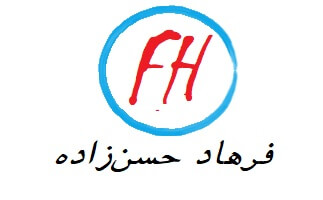Review of some selected books
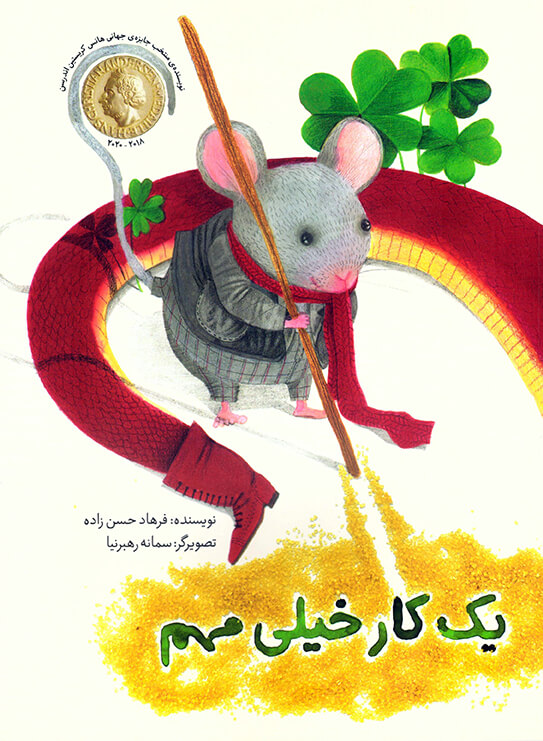
یک کار خیلی مهم
Yek Kare kheili Mohem (First Things First)
Tehran: Fatemi Publication, Tuti Books, 2022
Illustrator: Samaneh Rahbarnia A little mouse who loves watching the sunset comes across a snake on its way one day. Scared for his life, the mouse tries his best to come up with anything that would create a friendship between him and the snake. Would his efforts work? “First Things First” is a sweet story in the appreciation of friendship. It helps children understand that sometimes the unlikeliest friendships could be built with enough effort, passion, and care. We all have important tasks to do and everyone thinks his task as more important than that of others. Some easily get their important task done but some others have to go through a difficult path. For the baby mouse in this story, the most important task in the world is watching the sunset. However, in his journey he bumps into a red fiery snake. First, he gets scared but then he remembers his mother’s advice that if you get scared swallow your saliva and that makes you swallow your fear. The mouse swallows his saliva and his initiative starts to work. He talks to the snake with a nice language, befriends him and invites him to work jointly. He finally wins the snake’s heart. Now it is the snake that follows him for an important joint work. Watching the sunset.
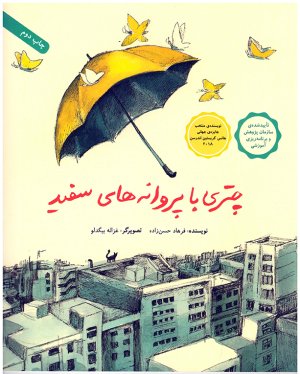
Chatri Ba Parvanehaye Sefid (An Umbrella with White Butterflies)
Tehran: Fatemi Publication, Tuti Books, 2017
Illustrator: Ghazaleh Bigdelou
There are two hours left before the arrival of the New Year, and everyone is trying to finish up last minute errands in the hustle and bustle of cars in the street and people carrying goldfish home for their Haft-Seen Tables. Ardalan wants to get his hair cut. Atousa is ringing the doorbell at the seamstress, to pick up her new dress. The florist’s son and daughter walk down the alley to bypass the crowds and get home to their Haft-Seen Table in time for the New Year festivities. The book tells the story of three groups of children in a certain city two hours before the Iranian New Year. The story takes place in a rainy city block. The flower-selling brothers and sisters took a pair of old yellow umbrellas dotted with white butterflies on the way home; when the interlacing of spaces occurred, a metaphorical yellow butterfly flew over the town overlooking everything, the story ends, and the yellow butterfly returns to the stowed umbrella, standing still. This is the complete story of the successful solution of the children’s plight. Going deep into it, readers can also read the poetic and philosophical meanings that are enduring.
 Barf o Aftab (The snow and The sun)
Barf o Aftab (The snow and The sun)
Tehran: Fatemi Publication, Tuti Books, 2018
During Keykhosrow’s reign, the border of Iran and Turan is attacked by wild boars; its people ask the king of Iran for help. Bijan, a young Iranian hero who’s Rostam’s grandchild, volunteers to fight off the wild boars and intends to leave. His father, Giv, objects but Bijan insists on going. Keykhosrow chooses Gorgin who is an older and more experienced hero but also a trickster to accompany Bijan. After seven days and seven nights, the two heroes arrived there to eliminate the boars. While Gorgin was resting in a corner, Bijan attacked the boars and killed off all of them. On their way back to Iran Gorgin begins to tell Bijan of Manijeh’s beauties, Afrasiab’s daughter, and persuades him to go to spend a while at Manijeh’s resort in Turan, Iran’s old enemy, and enjoy her company. Bijan who at first disapproves of this idea, slowly becomes captivated by Gorgin’s descriptions of Manijeh and falls to his trap. Bijan and Gorgin start for Turan and Bijan get the chance to meet Manijeh; after meeting her, Bijan falls madly in love with her. This fiery love blinds Bijan to the truth and puts him on an unfortunate path. When it is time to return to Iran, after failing to convince Bijan to stay, Manijeh drugs Bijan unconscious and takes him to her room in Afrasiab’s castle. In Afrasiab’s castle, the maids take notice of Bijan’s presence, their Iranian enemy, and report to Afrasiab. Furious, Afrasiab orders Bijan to be captured and hung but as fate decides Bijan is saved from death and thrown in a deep dark well instead. Manijeh is exiled from her father’s castle and remorseful spends day and night beside the well talking to Bijan. On the other side, in Iran, Gorgin had returned to Keykhosrow’s castle and given Bijan’s death news in his battle with the boars to the royal court but Giv thinks this Gorgin’s plot and asks the king to find Bijan and return him to Iran. Using the Cup of Jamshid, the famous orb of divination, Keykhosrow finds Bijan in a dark well in Turan and asks Rostam to set out for Turan to save him. Wearing the cloth of Iranian merchants, Rostam and his companions get to Turan and with the help of Manijeh they attempt to free Bijan at midnight. The story of Bijan and Manijeh is a famous Iranian mythical story that Ferdowsi, the 11th century poet, wrote down as epic poetry in Shahnameh. Farhad Hasanzadeh, the selected children and young adult author, has rewritten this story of Shahnameh in prose and recreated it for young adults; a love story, a love between snow and sun.
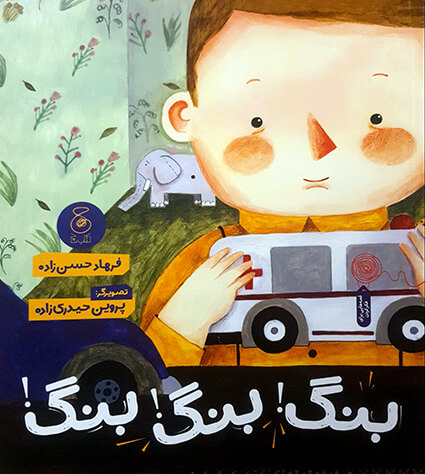
بنگ بنگ بنگ
نویسنده فرهاد حسن زاده
Bang! Bang! Bang!
Thehran: Cheshmeh Publications, 2021
Illustrator: Parvin Heidarizadeh
A gun is never the right gift. It is Arash’s birthday. Everywhere is full of balloons and twines and all the family have gathered around, eating cake. More Important than all this, is the fact that Arash gets many presents! Now is the time to open them all and he opens his parents’ present. They have bought him a beautiful gun. It has a long barrel and brand new shine, but Arash doesn’t like guns. He asks his father with a pout: “what should I do with this?” and his father answers well it’s obvious you hunt with a gun. Arash stamps his foot down and says: “I wish you had bought me something else.” His father is surprised and to show Arash how nice a gun is, picks it up and shoots at the leopard. Bullet hits the leopard’s head and knocks him down. Arash yells at him: “don’t” Arash’s mother gets thrilled and claps her hands. This time his father shoots at the brown bear, right at his forehead. Arash yells again “don’t” but they do not listen to Arash. The sound of Bang Bang Bang is everywhere and Arash thinks that he has to do something for the poor wounded animals… Peace, friendship and prohibition of violence are concepts that should be taught to kid from an early age. May be it can be said that these concepts are embedded in kids nature and stories only intend to remind them of these traits. Arash knows that taking care of animals is a must, He knows that he has to be aware of what goes on around him, and also knows that conflict and violence have bad consequences, but looks like his parents have forgotten these concepts. He must make them aware of their wrong doings, but they are so immersed in the happy gun game that they don’t hear him. Reading this story is a different experience for kids of over 3 years old; especially because the story goes on with illustrations that have hidden many points inside them and to discover them will be exciting for kids.
Rozbeh and Robzal
Tehran: Siyavoshan Publications, 2022
Illustrator: Maryam Andaz
It is a book from a series written by top Iranian authors. In this series, the publisher was looking for an interesting way to express stories to achieve concepts such as peace and friendship, cultural integration and communication between the countries of the world and recognition of special symbols in stories. In this project, Iranian writers with knowledge of mythological and archetypal figures of European and other countries countries have created a new story. Stories that bridges between cultures and establishes the atmosphere of coexistence and human communication between societies. In this story, Farhad Hasanzadeh has created an Iranian story based on the character of “Robzal” which has a special place in German mythological literature. In this story, a boy encounters Robzal in his fantasy world. The boy has already read a book about him but forgot. Until one day, he sees Robzal’s photo on a jam jar that was brought as a souvenir from Germany. In the imagination of a boy, he came to his house by eating Robzal jam. He sees his image in the mirror and asks him to solve his problems.
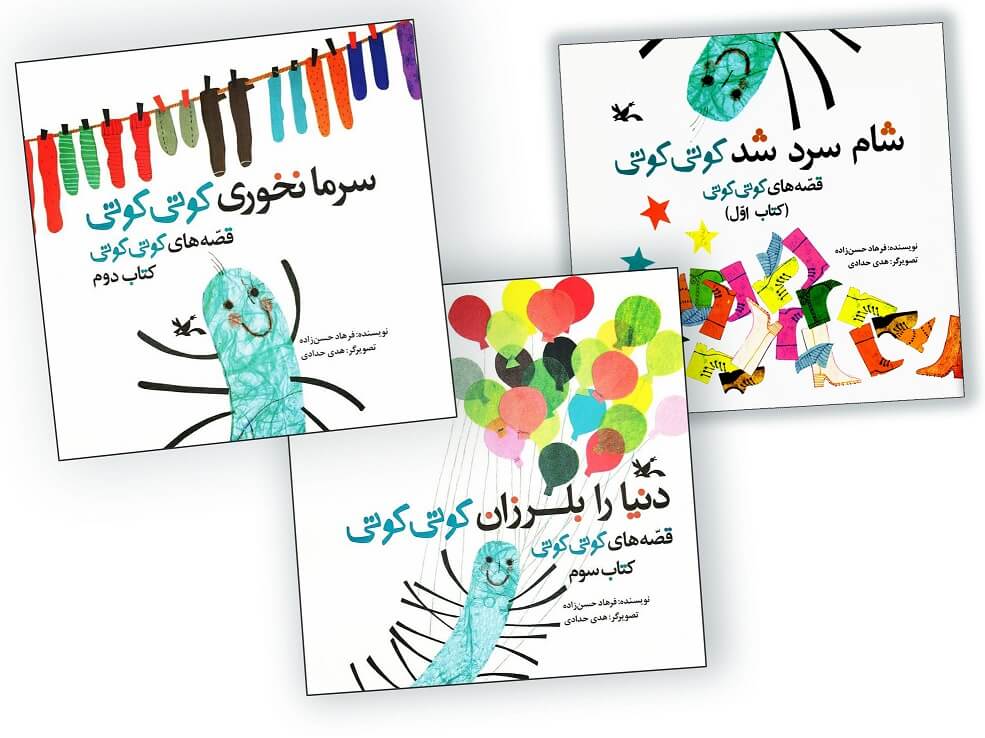 Ghesehaye Kooti Kooti (The Kooti Kooti Tales) (3 books)
Ghesehaye Kooti Kooti (The Kooti Kooti Tales) (3 books)
Tehran: Kanoon
Illustrator: Hoda Hadadi
Imagine that you have a thousand feet instead of two. When you put your first foot through a doorway, how long would it take for your last foot to go through the same doorway? What would you do on a football field, in a bathtub, etc.? The main character of Kooti Kooti stories is a millipede with a thousand feet who faces a thousand problems, and when he cannot solve the problems, he cries cupfuls of tears. When Kooti Kooti sees that a few of the neighbors have shoes, he asks his father to buy shoes for him. However, since Father does not have much money, he does as Mother suggests: each month he buys one pair of shoes for Kooti Kooti. Finally, after a few years, he has various types of shoes for all his feet, but now the pair he got in the first month has become too tight for him. When Kooti Kooti plays football, he steps over everyone’s feet. When he takes a bath, scrubbing the soles of his feet takes a whole day. Nobody is willing to play Atal Matal Tootooleh (a game in which counting the players’ legs is essential) because it is very difficult to count his legs. Kooti Kooti’s adventures are humorous, and while they bring the child joy and laughter, they strengthen the spirit of questioning and criticizing in the young reader. When one of Kooti Kooti’s shoes gets torn, he wails and whines, but upon seeing a small worm who neither has legs nor shoes and yet crawls laughingly as he goes to school, Kooti Kooti stops complaining. Some of the stories in the series are metaphorical and not only Kooti Kooti but the child audience are induced to think. More importantly, they help the child understand metaphors because metaphors are formed in the actions of Kooti Kooti. Like every other child, Kooti Kooti likes to play truant every now and again. So he moans and groans. His 55th foot is hurting. Pain shoots up his 220th foot. His 333rd foot is itching badly. His 442nd foot is swollen. His 678th foot… oh, no, it has caught a chill… and putting on an act, he grumbles. The young reader’s emotional intelligence is empowered along with Kooti Kooti’s because with Kooti Kooti, they experience their own inner needs as well as those of others and also experience how to interact with others. Kooti Kooti represents a young child whose parents do not understand his problem because they do not do what he does, like wearing shoes and trousers. Kooti Kooti does not want to be like his parents. He does not even want to be like Mrs. Fly, who tries on shoes once and then throws them away. He wants to be himself, so he embraces the problems wholeheartedly: because he loves shoes… because he loves trousers… he loves washing socks… More importantly, the child easily understands metaphors in Kooti Kooti’s adventures. In the Iranian children’s book market, Kooti kooti is one of the few comic works written for preschoolers. We know that there are few comic books, especially for young children, but Kooti Kooti’s humor is sweet and charming even for very young children. The book illustration has invigorated the characterization of Kooti Kooti, Mother, Father, Grandfather, and Grandmother. And it is inspiring for those youngsters who work on such artistic books. Kooti Kooti is fit for 4-10 year-old children. 4-7 year-old children who are incapable of metaphor comprehension but are metaphor makers can become familiar with metaphors through Kooti Kooti’s actions. 7-10 year old children who understand metaphors, but cannot make them are encouraged to create metaphors. The Institute for the Intellectual Development of Children and Young Adults (Kanoon), the publisher of the three-volume Kooti Kooti series, has published the first volume in Kurdish, English, Mandarin, Turkish, Arabic, Malay and Sweden (Swedish) as well.
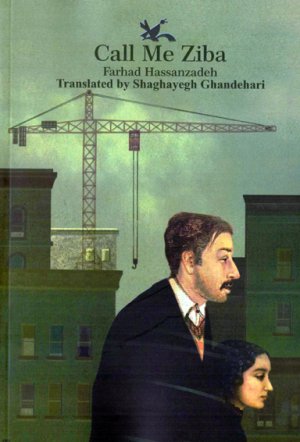
Call Me Ziba
Ziba Sedayam Kon (Call Me Ziba)
Tehran: Kanoon, 2015
The young adult novel Call Me Ziba is the latest book written by Farhad Hassanzadeh, dealing with guardianlesschildren, childlaborers, those living in the slums of Tehran the capital city of Iran, and huge social gaps in this city. The main character of the story is a 15 year-old girl named Ziba whose father is hospitalized in a mental hospital for an unknown period of time, her mother has got married and she herself lives in a dormitory of a welfare organization. Like his other novels written for young adults, Hassanzadeh has selected the first-person point of view. Narrating her most inner feelings affected by being released, Ziba raises sympathy in the reader. On her birthday, she helps her father run away from the mental hospital so the two of them can celebrate it together, have lunch and dinner in a revolving restaurant and Father buy Ziba a gift. On their first encounter, Ziba finds out that her father lacks psychological balance. He looks at her with eyes full of fear, rage, and a lot of words and arguments, eyes which are as scary as Ziba’s childhood was. However, unlike the other children in the dormitory who hate their fathers, Ziba loves hers. Father also loves Ziba. Ziba and her father need each other, but he sometimes becomes as frightful as a monster. Both want to have a good day together. However, recalling his memories, Father reaches the threshold of psychological seizure, and whenever he gets like that, Ziba has to make him take a pill. Her father has been a victim of terror in the days of war, having been affected by a blast wave there, which has harmed him psychologically. However, her mother says he suffers from periodic insanity and Ziba does not know how this insanity starts. Whenever he got nervous, he ran out of pills or money to buy pills, he had money but forgot to buy pills or forgot to take them on time, the house turned into a hell. It was Ziba who would curl up then, trying to suffer less from his father’s whipping. After being beaten by him, Ziba would go to bed, tearful and hurting, and the next morning she woke up with her father crying, apologizing, and caressing her. In spite of censorship in Iran, the author finds a way to dodge it very skillfully and implies Father suspecting Mother of cheating on him. On Ziba’s last birthday, he becomes suspicious of Mother and goes crazy and punches and kicks the heater. Some boiling water gets splashed on her face. Mother is taken to the hospital, Father to the mental hospital, and Ziba is left alone and confused. In order to make a living, pay the court for a divorce from Father, and support her addiction, she entrusts Ziba to a man called Aghabala. Her father had no clue that she had married Aghabla after getting a divorce from him. Aghabala has rented out Ziba to Ramazan, the newspaperman near Mellat Park,to sell flowers, tissues, newspapers and chewing gums for him at street intersections, and whatever money she gets, she gives to Ramazan every night. At night, Ramazan would take his own and Aghabala’s shares and give little to Ziba. Aghabala had even made Ziba steal things. He father did not know that at last she ran away from her mother and her husband’s place, becoming homeless and living on the streets and being helped by the very author of this book. And currently, she lives in a dormitory for guardianless children. One can find references to Ziba’s illusions, fear, and horror in the book, which are indicative of a harmed teenager, a wandering and depressed one. Ziba herself likes to take one of Father’s pills, so that she may forget her past. The atmosphere prevailing in the story describes the conflict between the slums and the downtown of Tehran, where glances, behaviors, cars, buildings, stores and banks humiliate Ziba and her father. A city where neither its restaurants, nor its cafes and shopping centers have a place for them. Ziba is anxious, waiting for a horrible accident. She regrets that she has been her father’s accomplice, but Father wins her over with flattery and bizarre arguments in the form of humor. His arguments are new and interesting to Ziba. He talks with words of a different kind. He tells her he is a roommate of a journalist, a writer, and a doctor. The day is approaching its end. Ziba wants to take him back to the mental hospital as she is afraid of his psychological imbalance. But now that he has tasted freedom, he rejects being taken back to the mental hospital. Her father intends to take her to a room above the tower crane. Ziba has surrendered herself to him completely like a crow chick and follows him. When they arrive at the room above the tower crane, they give a loud hoot of joy. They are standing on the top of a city which has ruined their identity and left them alone, one in a dormitory for guardianless children and the other in a mental hospital. Her father brings out the cake and the candles out of his trousers pocket and lights the candles, and Ziba plays a musical instrument. Ziba is worried because Father has got a bee under his bonnet to fly from an altitude where even crows do not dare to. Ziba gives him a pill, but he throws it down from the tower crane window. She gets more worried. In the end, white-clad officers of the mental hospital take Ziba and her father down, driving her father away in an ambulance. Ziba is standing alone, dumbfounded and confused under the rain in a half-dark blind alley when her phone rings. It is the author, asking her, “Why don’t you come here? The children and I are waiting for you with a cake in the dormitory.”
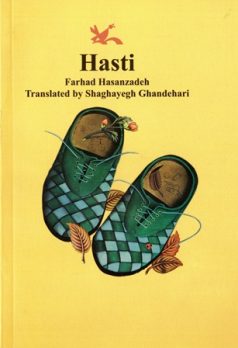
hasti
Hasti
Tehran: Kanoon, 2010
Hasti is a teenage girl who lives in south region of Iran with her family. The story begins with Hasti’s fight with her father. Hasti has a character and behaves in a way that is not considered appropriate for a girl according to the social norms of her community. She behaves in a way that is considered boyish. Actually, she is a girl who likes to be a boy. She loves to play football, wear boy’s outfit and hates dolls and all of these are not acceptable from a girl in a traditional community. The war between Iran and Iraq (1981-1989) adds to Hasti’s personal issues and makes everything more complex. With the emergence of war, Hasti and her family are forced to leave their house and city. Hasti’s Family live in the city of Abadan, close to the borders of Iraq and thus one of the first places to be involved directly in the war. Hasti and her family were among many other families who have to leave everything behind and flee. Hasti’s father is a weak and coward person and the insecurity that comes with the war adds to Hasti’s difficult relationship with her father. The father is not willing to become a vuluntary soldier and go to war, just like other men in the neighborhood, and fight for his country. In Hasti’s eyes the family is worth nothing for her father and he is not willing to make any effort to make his family’s life better. Not only he would not go to the war just as Uncle Jamshid did, but also does not have any job to support his family during the hard time. Birth of Hasti’s younger brother in the midst of the war and the father’s joblessness added to the family’s problems and turns life to a crisis. Hasti’s mom has a strong personality. She tries to protect and support the family but is not successful. Eventually, Hasti problems and issues that each teenager in any part of the world experiences at some point of her life. Gender identity is one of the most important issues that most teenagers get involved with at this point in their lives. Hasan Zade has touched upon this issue and shows how traditional and social restrictions may shake this identity. Hasti is a heroine who does not give in to the cliche and restrictions and tries to build her life the way she wants. Hasti’s gender identity issue is the core of the story and the other events become side stories. Hasti does not get along with traditional expectations of girls and women and is willing to make an example of being a girl that may be in conflict with many of the community’s values. Some of the characters in the story have sympathy with her, such as Hasti’s aunt, who is a college aged young woman and can be the representative of the intellectual section of the community. When Hasti runs away from home stays with her aunt who tries to help Hasti get rid of social cliché and discover her real self. This story has solid structure and narration. By creating conflicts and crisis in the story, the author keeps the attention of the reader and with a peaceful view point tries to picture disasters such as war and displacement. Hasan Zade spent his childhood in south of Iran and his childhood experiences helps him to create one of the most successful local fictions for adolescents in Iran. Hasti’s story shows how war can influence children’s lives and change their childhood. The characters in the story speak with southern accent and this beautifully reflects the milieu where the story occurs. Hasti is one of the most successful fictions for adolescents in recent years in Iran. It has not only been appreciated by the young readers but also has won several prizes from various organizations in the country.
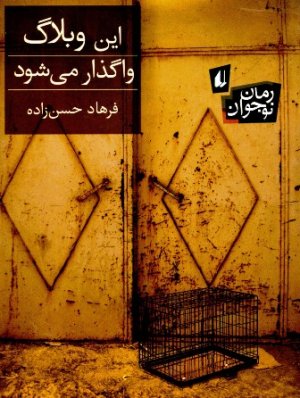
این وبلاگ واگذار میشود
In Veblag Vagozar Mishavad (This Weblog Will Be Transferred)
Tehran: Ofoq, 2012
Dorna is a teenage girl who loves literature and writing. She lives in Abadan (a horbor in south of Iran). She has a blog named A Bunch of Keys. Accidentally, Dorna she meets a bookseller named mr. Zaal and the story forms around this meeting. She finds an outworn notebook in an old book shelf in the back of mr. Zaal’s book store and reads it. Each chapter of the book is one part of the story that Dorna posts on her blog. Dorna goes back in Zaal’s lifetime and tells the story of Him and his love Fariba. As a young boy, Zaal has no family and works at a pet store (only selling birds). The owner of the pet store is a harsh man who does not have a kind heart. One of best parts of the story is when the pet seller rapes Zaal and causes severe emotional issues in the young boy to the point that he even tries to commit suicide. When the war between Iran and Iraq begins (1981), Abadan and other cities in the south turn into dangerous war zones. Life turns upside down and Fariba’s family who live in the same neighborhood as Zaal leave the city and all of a sudden Zaal’s dreams are ruined. Zaal who is in love with Fariba had long been waiting for the right moment to let her know of his love, but the war and then Fariba’s migration change everything. The war changes Zaal’s own life, as well. The pet owner and Zaal are also forced to leave their store behind and flee from the city. They flee to the desert outside the city and suddenly find themselves confronting Iraqi soldiers. Zaal takes advantage of this opportunity and runs away from the cruel pet seller. Gradually, other characters enter the story. Latif, is a cyclist, teenage boy who is a friend of Zaal and seems to be in love with Fariba secretly. It seems like there is a hidden love competition between the two boys. But, Latif’s destiny is to lose his legs during sever bombings on the city of Abadan. In this book, Hassanzadeh works with strong themes such as teenage love, loyalty and so on, and thus creates a situation where he can speak of the issues that teenagers experience and get involved with. The author describes Zaal’s love for Fariba with such wonderful details that is very exceptional in Iran’s current fictions for adolescents due to limitations assigned by the state officials. Female characters and their feminine characteristics are beautifully described. They are active and effective and fight for their love and dreams. Hassanzadeh tries to attract his readers and make them want to follow the story by creating characters who are real. He uses the opportunity of the story to speak of some realities which are dark and bitter, but the vehicle of literature gives the reader the opportunity to encounter them in a secure and healing way. The dark subjects that the author brings in his book are war and its destructive consequences such as displacement, migration, as well as, working children, sexual assaults and other violent behavior against them in workplace and psychological issues that are results of such behavior. Implementing items such as selling birds and birds in the cage can be symbols that picture Zaal’s situation as if he is a prisoner to whom problems and difficulties show up from all directions. However, the way the author brings about these issues seems to be the first thing that catches the reader’s interest. Each chapter of the book is a post on the blog. Sometimes, the author tries to get closer to the language of today’s teenagers and implement terms that are frequently used by them. This approach in literature of the book and selecting the form of a blog to tell the story are notable characteristics of this book. The author creates an interesting opportunity to unfold more details of the story by applying the form of a blog. In the story, the readers of the blog leave comments for the posts and some knots in the story are unfolded through these comments. This form also brings the people of current generation into the story as readers of the blog who leave comments. This media (the blog) provides the opportunity of making conversations for the young readers and thus engages them actively in and through the events of the story. To follow up with the story, they are led to read the posts and comments as well as the story of Zaal from the old notebook, put everything together like pieces of a puzzle and realize that mr. Zaal is the same figure as the young Zaal and is the boy who worked at the pet store. At the end, the readers realize that mr. Zaal has kept the keys of Fariba’s house with a hope that she and her family would come finally back to their house.
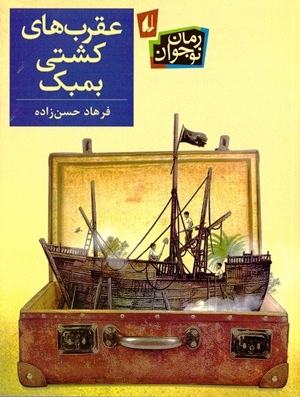 Aghrab haye Kashti Bambak (Bambaak’s Scorpions)
Aghrab haye Kashti Bambak (Bambaak’s Scorpions)
Tehran: Ofoq
Bambaak’s Scorpions is a novel about the life of some teenagers from Abadan, who work in a graveyard in the midst of the Islamic Revolution of Iran and political conflicts. Abadan is a city in the south of Iran with oil wells. These teenagers have formed a gang called “Scorpions” and gather in an abandoned ship called Bobmak. Kholou and his friends have found a suitcase and some photos and come across a family of the employees of the Oil Company. The father of this family, due to political activities, has been arrested and his son, having founded this group, has joined the Scorpions gang. Kholou has no mother and lives with his father. Bringing some forbidden books to the house, he makes some trouble for his addicted and illiterate father and gets lonelier than before, but after a while, the security police releases his father who knows nothing from prison. Affected by the revolutionary atmosphere of those days which are replete with political unrest, these young people make a dangerous attempt and knock out a policeman, thinking he is an influential agent of the secret security police, seize him and take him to their place, Bambaak. The policeman, whose name is Ghorban, is a neighbor and father of Kholou’s beloved girl. In fact, he is only a traffic officer who has even been ill-treated by the government. Policeman Ghorban becomes a friend of the children and as he is pursued by the police, he stays in the ship for some days for the danger to pass. In addition, Kholou’s father marries a woman working in the graveyard and brings her with her children to his house, but of course kholou reacts unfavorably to this. Telling Ghorban’s wife and daughter that he is alive, Kholouin a way confesses his love to his beloved girl, and, in the end after accepting his stepmother and the new conditions in his life, he returns home. The paramount feature of this story is its natural and indirect humor. The playful acts which make the story attractive are appropriate for teenagers. Even the swear words are expressed in a way that they are fundamentally erotic but not offensive and, with a brief implication, appeal to the intelligent reader. The writer has adeptly incorporated the humor found in the language of people living in the south of Iran into his work and draws upon different techniques of humor such as verbal irony and situational irony. Using comic situations which go beyond mere puns and verbal irony have made this work worthier than even his own other works. Considering the lack of comic young adult novels in Iran, Bambaak’s Scorpions is noteworthy and with a special place. The next point is that the story is told from a teenager’s point of view. Kholou, the main character of the story and a member of the gang, narrates the story in response to the author’s request and in some cases he makes some references to the author, using the money from him to buy drugs. After his father is arrested, Kholou becomes completely alone and feels that he needs his father in spite of all his bad characteristics. After internal struggles, he copes with his stepmother and his new brothers and sisters. The sympathy and friendliness found among his teenage peers are manifest in the gang. Whatever they do, they do it together and the loneliness and family weaknesses are somehow filled by his peers. Bambaak ship is a hangout to which the members of the gang resort in order to escape social disorders, family problems and financial issues. Introducing a new boy from a different social class into Scorpions gang is a positive act in order to build a bridge between different social classes while the differences are reveled in detail throughout the novel and an emphasis is made upon them. This does not only show a conflict between that boy and kholou or his friends but also reflects the mess in which the people of southern Iran live, especially given that the newcomer comes from a middle-class family and other people are below poverty line and have no access to the minimums. One can easily see the effect of political ideologies on teenagers and their participation in social movements in large numbers throughout the story. Political slogans enter their daily language and, given that adolescence is a period full of excitement, they affect their actions although Kholou and his friends do not understand the exact meaning of the slogans and the ideology behind them; a superficial meaning of the slogans suffices them. The need for an excitement is manifested in selecting a name for a group consisting of friends, reaching its peak when they kidnap the policemanGhorban. The teenagers from all walks of life like to play a role in protests and the revolutionary atmosphere. Ideological harms and teenagers’ ignorance of mechanisms dominating them are revealed indirectly in the story. Regardless of the prevailing political aspirations, the teenagers use ideological slogans just to strike a pose; for example, in order to show off in the presence of his beloved, he calls a simple quarrel a revolutionary act. Moreover, the story shows how stories and movies can be effective in forming models and desires for love among teenagers, just as the teenager intends to kidnap his beloved girl, like what he has seen in popular movies. Bringing up the subject of teenage love with physical features, idealism, and romantic fantasizing is another characteristic of this book. Although there is no physical contact between Kholou and his beloved, the narrator’s descriptions of the girl’s physical beauty are noteable.
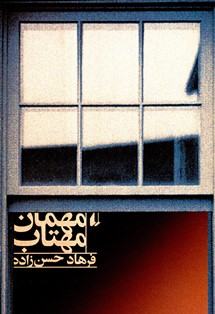
مهمان مهتاب
Mehmane Mahtab (The Moon’s Guest)
Tehran: Ofoq
Fazel and Kamel are inseparable twins, as a single soul inhabiting two bodies. However, when Iran-Iraq war begins, their paths separate. Kamel regards the onset of war and their departure from Abadan as an opportunity for moving to a new world, for progress and education. But Fazel chooses a different path: staying and fighting. As time passes and various events occur, each brother in his chosen path changes gradually and enters a new phase of his life. When the family arrives at Mahshahr, Fazel decides to go back to Abadan and fight next to his brother Adel, who joined the Resistance from the beginning, in order to keep Khorramshahr from falling. On his way back to Abadan, Fazel meets a fellow traveler, a pregnant woman named Parvaneh, who like Fazel, is looking for someone: her husband Nossrat. As soon as they reach the town, Parvaneh sees her house in ruins. Only a mound of soil, bricks, and tangled girders remain of her home. Spotting the baby cradle that is jutting out of the debris overwhelms Parvaneh. Fazel takes her to his home, and in order to find Adel and Nossrat, he goes to see Ali the kebab seller, their mutual acquaintance. Fazel and Kamel used to work for Ali during summer breaks and Adel knew Ali from before. Ali has now joined the supply unit in the rear and cooks for soldiers. He informs Fazel that Adel has been killed in an explosion and takes him to his grave. Gradually, Fazel becomes acquainted with the truth of war and the ever-lurking danger. However, Kamel and the rest of the family, who have chosen migration, are not living very comfortably either. Not yet being aware of the realities of the war, people in other cities do not treat them well and regard them as gutless deserters. In Shiraz, they are thrown out of the park at night, and, in Isfahan, Fazel and Kamel’s Uncle Aziz’s car is stolen. Kamel, who up to that point had hopes of going to Tehran, studying, and becoming an engineer, has no choice but to stay in Isfahan with the family. Father’s leg is broken in an accident, and Kamel becomes the family’s breadwinner. He witnesses the sufferings and degeneration of many families who have become displaced like them, staying in a temporary camp. His mother has bought a sewing machine to help with the expenses by tailoring. His sister cannot attend the university anymore. on the other hand, being displaced and under financial strain, some of his peers, like his cousin Louis, have become delinquents and thieves. Kamel is engaged in an internal struggle all the time, comparing himself to Fazel. He thinks others regard Fazel’s choice as more proper than his, inwardly admiring Fazel and condemning him. Fazel is now Ali’s right hand. He accompanies Ali from daybreak and provides the supplies to the rear with his help. Day by day, the siege becomes tighter and the situation more difficult. Nossrat asks Fazel to take Parvaneh to a safe location. Fred, who is reluctant to leave, finally accepts as he cannot say no to Nossrat. He takes Parvaneh to Shiraz and returns to Abadan immediately. He is on his way back, but the road is closed from a point onward. Perforce, he goes on foot. He becomes the traveling companion of a motley group, individuals who are each on their way to Abadan due to their own ideas and wishes: one to trade, another to stay and keep the town alive, and yet another to retrieve the treasure he has hidden somewhere in Abadan. One of the travelers gets killed on the way and Fazel sees how death moves neck and neck with them. At last he gets home. Now the shadow of the war has fallen more heavily than before. Granny Jerman, the old Armenian woman, has stayed back plus one or two others. He returns to his old job helping Ali, the kebab seller, and working with the supply line to send provisions from the rear to the fighters. Father, whose leg is better now, comes to Abadan in search of Adel and Fazel. Fazel has to give him the news of Adel’s martyrdom. Father needs to return, but he does not insist on Fazel’s returning with him. He now believes that Fazel has the maturity to operate and survive on his own under those urgent circumstances. Fazel stays behind to continue defending the town and supporting the fighters. The situation at the camp worsens and becomes harsher every day. Father now knows that he has diabetes and loses one foot to infection. Kamel’s internal struggle continues. He is now very distant from his dreams. He is neither going to school nor is he residing in the capital. His parents insist that he should not work and should study instead, but he now feels more responsible for his family. However, he still feels Fazel’s presence, as if it is pulling him like magnet. He feels he has to go, that Fazel is calling him. Finally, it makes up his mind. There is a recruiting in the camp for soldiers to be sent to the front. Mother and Father are against his decision at first, but at last when Father’s relative comes to inform Father of a job opportunity, his parents give their consent for his going to the front and, in truth, for his joining Fazel. The war is going on in Abadan with more intensity and cruelty than ever before. Just a few minutes after Granny Jerman’s son, who has come from Germany for his mother, leaves with her, Granny Jerman’s home is blotted out by a missile. Before departing, Granny Jerman gives her late husband’s empty gun to Fazel, hoping that it might be of use to him someday. In a difficult night, the fighters and the remaining citizens succeed in driving back the Iraqis, who have entered the town from the other side, and save the town. That night, many get injured or killed. However, fighters’ resistance to keep Khorramshahr from falling is fruitless. Khorramshahr falls at last. Fazel, who is now a few feet away from the enemy, incidentally enters a house that has fallen into Iraqis’ hands, and an unexploded missile is suspended through its kitchen ceiling. One of the Iraqis notices Fazel’s presence, but Fazel threatens him with Granny Jerman’s gun and manages to get the Iraqi soldier’s weapon. Following an explosion, the missile and the kitchen gas cylinder explode, Fazel is badly burnt and is sent on a launch to another town for treatment. Parvaneh and Nossrat go with him on this trip. Everybody is heartbroken and in despair over the fall of Khorramshahr and the fact that many fighters, friends, and fellow townsmen, especially Ali, the kebab seller, have been martyred. Another boat comes towards them. Fresh forces are aboard it. Fazel feels Kamel’s presence and catches a glimpse of him on the upcoming boat. Kamel also stares at those who are aboard the launch. Fazel must be somewhere nearby. Fazel’s face is totally burned, but Kamel does not need to see his brother’s face to be able to recognize him. He can smell Fazel in the air. He jumps into the water and finally gets in front of his long-separated half — like a mirror. They are next to each other again, both with the same will and the same wish. The Moon’s Guest is a dual narration of the early days of Iran-Iraq War. Many books have been written about this war and what went on in the fronts. However, at the time that the Moon’s Guest was published (1996), few works had focused on normal people who were hurt and displaced because of the outbreak of the war. Migrants and regular citizens who had to leave their homes when the war started are a main part of the reality of the war, and it took years for them to be seen, for other people to learn what they had gone through. The Moon’s Guest not only tells the events happening at the front line, but also narrates the lives of those people who were forced to leave peace and happiness in their defenses homes and step onto a path whose end is not known to anyone. They are just looking for a safe, quiet corner to rebuild their lives, but sometimes they are not admitted to urban areas and sometimes they are regarded with contempt for their inevitable escape. Their children’s dreams are obliterated and their teenagers get sucked into addiction and delinquency. War does not just kill people physically, it blemishes human dignity and injures the soul. Hasanzadeh portrays this aspect of war beautifully, and of course bitterly, in the Moon’s Guest. He has successfully bridged the two aspects of all wars, namely the political and the social aspects, depicting both of them tangibly and realistically. In fact, the two characters Fazel and Kamel each symbolize one of these aspects and the two aspects converge at the end of the story because they are, in fact, inseparable. The ruins brought about by war are not limited to the front lines, they pervade the deepest layers of society. Hasanzadeh, who is a war migrant himself, has actually reproduced his life experience in this novel. The Moon’s Guest is like a message to the post-war generations, so they would know what wartime teenagers went through and how they faced the fiend of war, both those teenagers who were present in the battlefield and those who, in search of a safe haven, wandered through various towns and villages. May the post-war generations think of peace and strive to achieve a world without war, violence, and bloodshed.

کنار دریاچه نیمکت هفتم
Kenare Daryache Nimkate Haftom (The Seventh Bench By the Lake)
Tehran: Ofoq
“The Seventh Bench On the Lake” is a collection of short stories, one of Farhad Hasanzade’s favorite genres. Using this genre, he tries to picture children’s unique and special moments. In many of his short stories such as this collection, Hasanzade takes on a comic language in order to approach the reality of Iranian children’s life experiences. This book consists of seven independent stories. The stories share the same style and similarities in content and this is what differentiates this collection from Hasanzade’s other books. All of the stories in the collection are about difficulties in children’ lives that are imposed to them by the adults’ logic and will. Difficulties such as teachers’ domination over children’ personal issues, emotional and sexual assaults, domestic violence against children, adults taking advantage of adolescents’ emotional issues and so on are some of the themes that are reflected in the stories. The first story is about a group of classmates in an all-girls school. They are preparing themselves to welcome the return of a classmate who has been away for a while. They try to support their friend by doing some things for her and giving her a gift (a diary with lock) away from the strict school rules. At the end of the story we find out that the absent student is an adolescent girl and the reason she left the school is that one of her teachers read her personal diary and used the content against the girl in the class in order to punish her. This led the girl to undergo a severe emotional collapse. “Like all Rabbits” is the title of one of another story in the collection. The story begins with describing a young boy who is looking at the pets from behind the window of a pet shop. After describing the boy’s inner encounter with the pets and their buyers, he enters the store and faces the shopkeeper who increasingly touches the boy’s body as he takes care of the boy’s order. The shopkeeper tells the boy that he can have a rabbit with a lame leg with a lower price or even for free only if he stops by the shop more frequently. At the same time, another customer enters the store and the boy who is very anxious leaves the store and that is when we see he has a difficulty in walking, as well. “Cotton Islands” is a story about adolescents’ romantic relationships in a traditional community in a large metropolitan area. The narrator is an adolescent girl who has a secret distant relationship with a boy who lives next door. A vague and stressful relationship that goes no further than just looking at each other secretly and sending secret messages to each other. This relationship has become possible in the modern social environment of the city, but, the girl’s parents realize and do not accept it. The girl’s father is very upset and reacts so harshly that the boy accidentally falls down from the roof. The whole of the story is narrated by the girl a few days after this event and we become aware of the story while she is sleeping in her bed struggling with her thoughts. The father is sent to prison and the girl’s family is experiencing poverty and isolation, or as the girl in the story says: the members of the family are isolated on their cotton mattress islands. In these stories Hasanzade speaks of subjects with a journalist’s eyes. This is due to his involvement in the field of journalism. He has been successful in creating great stories out of these journalistic contents by making skillful use of various storytelling techniques such as choosing narrator, point of view of the story and his way of telling the story. In addition, Hassanzadeh takes the reader on a journey into different inner worlds of human characters of his stories without proposing any judgments about their deeds and thoughts. He simply opens up their inner world to us by applying various techniques such as describing characters’ encounters with each other, narrating their thought life, and describing their worldviews. The conflicts in these stories reflect real struggles in human relationships, conflicts that are inevitable because of differences in the inner world of human beings. Hassanzadeh reflects these differences in his descriptive narration technique. The climax of these human struggles can be seen in the difference between the world of adults and children. It is in these encounters that children experience the world of adults and become mature, their feeling life changes and they become more realistic and solid in their behavior and feelings. The general background of the stories in this collection is vague and only unfolds by going forward in the story. The vagueness of the stories gives the reader the opportunity to interpret them in various ways. On the other hand, this vagueness reflects the conflicts of inner worlds of thoughts and feelings and worldviews of the human characters. The author creates clear pictures of inner feelings and emotional status of his characters. However, it is these characters themselves who are not successful in understanding their own and the other people’s inner needs and feelings. This vagueness of realities helps Hasanzade to include touches of unrealistic genres in the general realistic style of the stories without leaving the reader up in the air wondering what is going on in the story. This is specifically seen in these two stories: “The Elf’s Second Grade” and “Fish’s Tears, Fish’s rehearsal”. What makes Hasanzade’s collection of short stories more important and differentiates it from works of other authors is his courage to approach challenging subjects. At times, he even goes as far to break taboos and push boundaries by writing stories about subjects that have long been forbidden to approach. He tries to approach these subjects from children’ view point and show how they see and experience theses problems. His special interests in the status and quality of children’ life in urban environment in Iran’s changing situation is a new approach in Iran’s children’ literature. Not only he tries to reflect daily life of children in urban areas, but also he pays attention to children’ hidden and deep feelings and their understanding of the world. Speaking of children’ rights, such as, their privacy, freedom of human relationships, emotional and sexual health in urban areas and vulnerability to the world of economy and politics give a prominent figure to this collection of stories. The descriptive, comical, and at the same time logical language of this book, as well as, its intimate approach to adolescents’ issues grabs the attention of the young reader and motivate him to follow the stories to the end.
A selection of magazines and media
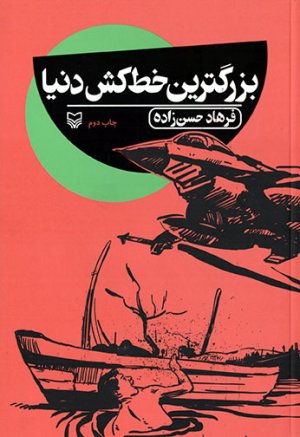
The Prominent Figures in Children’s Literature in Iran Written
by: Roohollah Mehdipoor Omrani
Hassanzadeh is a gifted writer for children and young adults who has a fluent, simple style but a realistic, visionary approach in his narration. Hassanzadeh is inclined to the teen’s literature, especially longer stories and novels. Providing numerous images and viewpoints, Hassanzadeh looks for new styles in narration of stories. Accordingly, he practices a new style of narration in his book, entitled, “Charlie Game”. He writes surrealistically in this story, mincing fiction with reality. In this story, he’s concerned with poverty, tramps’ lifestyles, and teen venders in his society. Hassanzadeh considers poverty, misery and runaway teens as stigma for the whole society in his short story, “Dishlamboo”. His unique innovation is in a section-by-section style of narration which corresponds with the road signs depicting the distance between cities on a bus journey. The two stories, “Charlie Game” and “Dishlamboo”, have simple, straight-forward plots, but the rhythmic, harmonious diction and narration replaces the lack of conflict in the story. Hassanzadeh’s imagination and creativity look for innovations in narration. He uses the modern urban life symbols and estranges the routine social life to penetrate its apparent, hard shell to discover its real kernel.
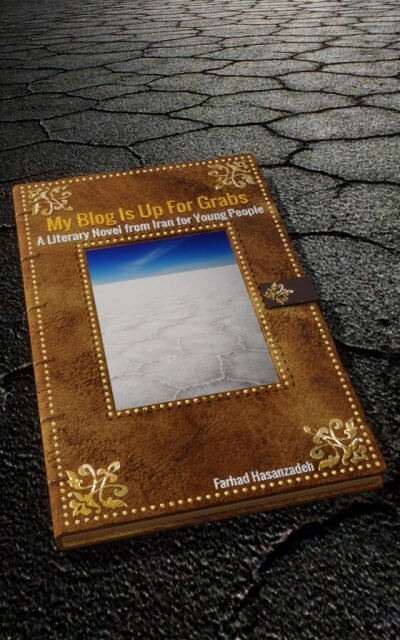
About the novel, “This Weblog Has Been Transferred
Written by: Banafsheh Mahmoodi
One of the most fantastic styles of writing is narrating a story at the heart of another. The reader will then read two stories simultaneously. Dorna is a teen girl who lives in Abadan. She finds a diary in a book shop storage which contains a love story. She is so excited about this story that she borrows the diary from the owner, who is in fact the shopkeeper. She uploads some parts of the story on her weblog, called, “The Keys”. The audience of the weblog will read about the story of Zal and his teen love. Zal used to live and work in a Birds Shop when the war started. He was head over heels in love with his neighbor’s daughter, Fariba. But war separates them for a long time. Fariba’s mother who has decided to leave the city along with her daughters due to the war leaves the keys to their house to Zal so that he takes care of it. The keys make Zal stay in Abadan and wait for his beloved. Dorna shares this story with many people on her weblog, but it cannot make a change and find Zal’s beloved one. The most important characteristic of the novel, “This Weblog Will Be Transferred”, is its innovative plot and form. In fact, the novel is presented in form of a weblog, and the comments the users have left on its pages. The audience will get to know the main characters of the story through the posts Dorna leaves on her weblog. But the writer has used the common form of writing a novel where Zal’s diary is presented in series on the weblog. Since the narrator of these sections is Zal, the story is presented through his viewpoint; consequently, all the audience’s judgments and affections are affected by Zal’s ideas and emotions. Farhad Hasanzadeh has stated that the novel is the result of thinking about the subject for seven years. He was going to write a story about weblogs and social networks and slept on the idea for seven years. He came up with Dorna’s story eventually. To check the attractiveness of his story, Hasanzadeh has uploaded some parts of the story on a weblog, called, “The Keys”, and has gathered the comments on the weblog and used them in some parts of the story. Farhad Hasanzadeh, who has experienced war in his teens, has applied his own experiences in his novel, like what he did in “Moonlight’s Guest”, to make the story more realistic and believable. It is the story of a one-way love and the time which has gone. This Weblog Will Be Transferred, Ofogh Publishing Co., First published in 2013, 144 pages, 2000 volumes
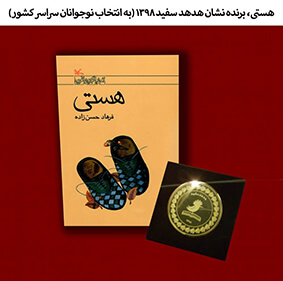
Criticism on “Hasti”, the most read novel in Kanoon centers in 2011
Written by: Shadi Khoshkar
Hasti, the Girl Who Likes to Be Herself You read just one chapter of the book, and you will find out that you face a new character. You will meet Hasti, a Tomboy. She acts so much like boys that only the taxi driver does not think that she is a boy. At the beginning, even the reader might think that the narrator is indeed a naughty boy like many other stories. Having a heroine has saved the story from being repetitive. It makes the story even more attractive. But the author has got a difficult task to make the character believable in all those ups and downs in her life. But it is not the whole story. When you are getting to know Hasti, a catastrophe occurs. The war between Iran and Iraq begins and makes Hasti and her family emigrate. I wonder whether the author has first created Hasti’s character and then decided to put her in the war zone, or he has decided to narrate the story of war right from the beginning and then dropped Hasti in the middle of it. In either case, war shatters both your mind from the focus on Hasti and Hasti’s life dramatically. War creates a new atmosphere to the whole story, which plays a vital role in the plot. Hasti is a bold girl who is not understood by his parents, especially his father. But now they are in the middle of a war, and everything has changed. It has drifted them away from home. They face new characters, such as their uncle who has decided to stay in the city and defend it, their grandmother who waits for her, and their grandfather who is afraid of the war. These are representatives of their groups in the society. On the other hand, war can reveal the complexities of different characters, especially Hasti’s. In contrast to her father, Hasti is a brave girl and returns to her city to defend it. Bicycle weekly magazine, 2011
 “The Scorpions of the Bambak Ship” (Published by Ofoq publishing house, 2008)
“The Scorpions of the Bambak Ship” (Published by Ofoq publishing house, 2008)
Written by: Zari Naiimi, Bicycle Magazine
Although the novel does not have a nice title, the adventurous story involves a gang called, “Scorpions” and is narrated by Khaloo, a teenager from Abadan. Khaloo and his friends, Shokri, Mammad, and Manoo, have made up a gang, called, “Scorpions”. The moment the Scorpions are introduced in the first chapter, you cannot put the novel down. Although the first chapter is set in the grave yard in the middle of the night in horror among the dead, these four teens like wandering ghosts haunt both the grave yard and the audience’s mind. Khaloo narrates, “You have to recruit in the Scorpions if you want to feel like heavens. Now that I am writing I am unable to enter into the gang in the introduction. I cannot separate some parts of Khaloo, Shokri, Mammad and Manoo’s dialogue to show them who they are. But it is what I am looking for: a sheer author, a writer who just writes and narrates the story.” In Farhad hasanzadeh’s novel, it has happened. He just writes and Khaloo narrates the story. The author just writes the story. He does not hide behind Khaloo, Shokri or the scorpions. He stands aside. The scorpions talk for themselves. That makes all the parts of the novel attractive, adorable and at times humorous. It is not the humor made by the author; rather, it is the humor which runs throughout the teens’ lives in their sentences, machine-talks, looks, glances, and interpretations, like the way he looks at his father and his snoring or the story he narrates from the revolution time. Humor runs in the air in the context of the whole story. You can smell it in all parts of the story, even Khaloo’s chattiness is not boring or annoying. That is what I call the delicious taste of happiness. Life is great when you can taste the happiness through the pages of a novel or a story, chew it under your teeth like pomegranate seeds and swallow its syrup. I do not exaggerate. I truly believe that a story can be a piece of the heaven, don’t you?
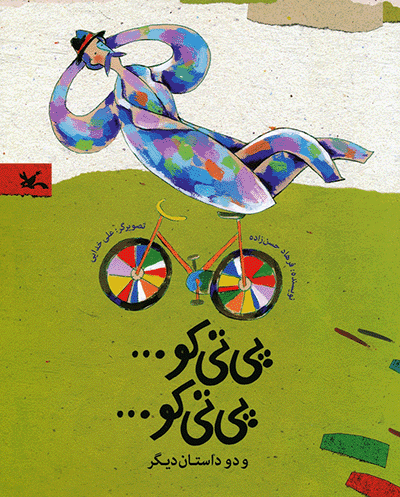 Gallope
Gallope
(Published by Kannon)
Written by: Ali-allah Salimi,
“Gallope”, a collection of short stories, contaisn three fanciful stories, which raises some philosophical questions and queries for children’s inquisitive minds. While simply stated, it deals with extremely complicated issues. The collection is notable from various aspects. First of all, one of the principles of children’s stories is to write in simple language, which is observed in this book. The next point is to demonstrate childish fancies and imaginations which exist in all the stories of this collection, beautifully merged with a poetic outlook, creating a fantastic atmosphere which is quite attractive to their young audience. Another important characteristic of these stories is to present deep philosophical concepts in simple childlike language. In the middle of fanciful narration of the stories, simple philosophical questions intrigue children’s minds. In the first story of the book, ‘Gallope’, a naughty foal painted on a painting on the wall feels imprisoned in the frame and would like to set free. He gallopes here and there and shakes the frame of the painting so hard that it falls off the wall. The golden frame along with the painting and the foal falls on the ground and the story ends there, but there is still a question put forward to the young audience. In the last paragraph, you will read, “The niddle on the wall did not stand all those shakings and movings and was loose then. The hammer was deeply asleep. The niddle finished all the weight and the story there with a tiny move.” A few lines later, you will be asked, “The golden frame is broken and thrown away in the basement, but what has happened to the foal?” Naturally, the young audience would wonder where the foal is. The answer to this last question could be different for different people who read this story. The open ending of the story has been designed to have such a wide range of answers. The most optimistic answer to the question, which might be even the simplest and the most available one, is that the foal has reach its wish and has set free when the golden frame fell down and broke. The author, however, has not reassured the audience about this simple response and has let the children have their own interpretations as well to end the story in any way they would like to. Children prefer this ending more nowadays.

